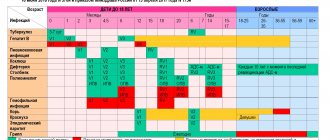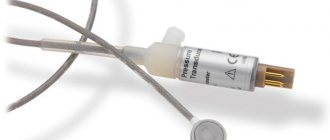In the first week of life, a newborn (early neonatal period) may experience a disease such as asphyxia. This pathological condition occurs due to oxygen deficiency in the child’s body (its individual tissues and organs), which is associated with impaired respiratory function. Neonatal asphyxia (NA) is determined in the first minute of a child’s life by the child’s lack of breathing. Sometimes the clinical manifestation is characterized by unstable, convulsive respiratory movements against the background of myocardial functioning. A child with AN, depending on the severity of the disease and timely medical care, may have different prognoses. The pathological condition requires immediate resuscitation.
General information about the disease
Asphyxia is diagnosed in 4-6% of children. Moreover, the percentage varies depending on the degree of prematurity of the fetus. In babies born before 36 weeks, the incidence of pathology reaches 9%, and in children born after 37 weeks it decreases to 1-2%.
Scientific definitions of newborn asphyxia boil down to the fact that the child cannot breathe independently or makes superficial convulsive breathing movements that do not allow the body to receive sufficient oxygen. The authors consider infant asphyxia as suffocation, in which other signs that the fetus is alive remain: there is a heartbeat, the umbilical cord is pulsating, the muscles are weak but contracting.
The reasons for the development of newborn asphyxia include a complex of risk factors that disrupt the blood circulation and respiratory functions of the fetus in the womb and during birth. The most common reasons include:
- conflict of Rh blood between mother and child;
- abnormal fetal development;
- pathologies of the nervous system in a baby;
- circulatory disorders, heart disease in the baby;
- intracranial injury that the baby received during the birth process;
- infections affecting the fetus in the womb (chlamydia, herpes, rubella, etc.);
- extragenital pathologies of the mother (thyrotoxicosis, anemia, diabetes mellitus);
- infectious diseases in the second and third trimesters;
- complicated childbirth;
- premature or post-term pregnancy;
- bad habits of the mother (effects of alcohol, nicotine, drugs on the body);
- malnutrition during pregnancySource: Asphyxia of newborns. Zhetpisova L.B. West Kazakhstan Medical Journal, 2011.
The most common cause of asphyxia is intrauterine hypoxia, that is, the baby lacks oxygen in the womb.
Whatever the causes of the pathological condition, it causes the same processes in the child:
- disrupts metabolism and blood circulation;
- thickens and increases blood viscosity;
- damage is caused to the brain, liver, heart, adrenal glands;
- organs swell, bleeding occurs;
- disruptions in the functioning of the central nervous system occur.
The longer the body feels a lack of oxygen, the more serious the degree of damage to tissues, organs and systems becomes.
What happens during asphyxia?
What happens in the body of a newborn baby at the time of asphyxia? Regardless of what exactly caused the asphyxia, the child begins to immediately change metabolic processes, blood microcirculation and hemodynamics. How strongly these changes will be expressed depends on the duration of asphyxia and the degree of its intensity.
During acute hypoxia, the child's total blood volume increases significantly. This occurs due to the fact that the volume of red blood cells circulating in the blood increases. In the event that acute asphyxia develops against the background of chronic fetal hypoxia preceding it, hypovolemia develops. Hypovolemia is a change in blood consistency: it thickens, its viscosity increases, and red blood cells and platelets acquire increased aggregation ability.
In the internal vital organs of a newborn child - in the liver, in the kidneys and adrenal glands, in the heart and brain - swelling and hemorrhages that occur as a result of tissue hypoxia can be detected. Due to a decrease in peripheral and central hemodynamics, the number of heartbeats decreases and blood pressure drops. Due to disruption of the normal course of the metabolic process, the urinary function of the kidneys is impaired.
Main signs and symptoms
The most obvious diagnostic sign is respiratory distress. It is this that subsequently leads to disruption of the cardiovascular system, weakening of the child’s muscle tone and reflexes.
Clinical manifestations of moderate asphyxia:
- lethargy, weakness;
- decreased motor activity;
- weak reactions;
- depressed reflexes;
- low-emotional cry;
- tachycardia;
- arrhythmic breathing, sometimes with wheezing;
- the skin is bluish, but can quickly turn pink.
The child's condition is considered moderate. During the first 2-3 days of life, he is in a state of increased excitability, which can be replaced by a syndrome of depression, weakness, and lethargy. The condition manifests itself as small tremors of the arms and legs, disturbed sleep, and weak reflexes.
In severe asphyxia, the clinical picture includes:
- lack of cry at birth;
- reflexes are severely depressed or sharply reduced;
- the skin is bluish, pale, with a “marble pattern”;
- breathing is shallow, arrhythmic and periodically absent;
- wheezing is heard in the lungs;
- the heartbeat is weak, dull;
- convulsions.
If acute severe asphyxia is successfully overcome, breathing normalizes within 2-3 days and reflexes are restored. Source: Fetal hypoxia and asphyxia of the newborn. Kuznetsov P.A., Kozlov P.V. General Medicine, 2022. p. 9-15.
Main morphological changes
- meconium in the amniotic fluid, as well as on the skin of the newborn
- the newborn's colon does not contain meconium
- cyanosis of the skin and mucous membranes of the newborn
- swelling of the newborn's brain, its membranes
- pinpoint hemorrhages in the serous, mucous membranes, internal organs (symmetrical, 2-sided)
- dystrophic changes in the parenchymal organs of the newborn
- aspirate in the respiratory tract, lungs, the presence of hyaline membranes, edema and atelectasis of the lungs.
Types of newborn asphyxia
Classification is carried out according to several criteria. First of all, depending on the time of development of the pathological condition, the following are distinguished:
- primary, or intrauterine asphyxia - develops directly in the womb;
- secondary, or extrauterine asphyxia – occurs in the first hours of the baby’s life.
In turn, primary asphyxia is also divided into two subtypes:
- antenatal, or chronic - develops even before the onset of labor;
- intrapartum, or acute - occurs during the period of uterine dilation and fetal birth.
Rules for caring for a child who has suffered asphyxia
In order for the child to recover from the effects of asphyxia as quickly as possible, it is very important to provide him with proper medical care. The child should be completely at rest, and his head should be in an elevated position. Intensive oxygen therapy for all babies without exception who have suffered asphyxia is very important.
Children born with a mild form of asphyxia are placed in a special oxygen tent. This tent is a kind of dome, inside of which there is a high oxygen content. The child spends there from several hours to several days, depending on his state of health.
In the same case, if the child has suffered moderate or severe asphyxia, he should be placed in an incubator. Oxygen is supplied to the incubator; its concentration inside should be approximately 40%. In the same case, if for some reason the maternity hospital does not have the necessary equipment, oxygen can be supplied through a special nasal cannula or through a breathing mask.
Very often, a newborn baby needs repeated suctioning of the contents, usually mucus, from the baby’s upper respiratory tract. Careful monitoring of indicators such as bowel function, diuresis, and body temperature is also necessary.
The first feeding of a child who has suffered mild to moderate asphyxia is performed approximately 16 hours after birth. Those children who were born in a state of severe asphyxia are fed for the first time after 24 hours, using a special tube. But the question is about that. When a baby can begin to be put to the breast is decided individually in each case, depending on the child’s condition.
Classification of asphyxia according to the Apgar scale
To assess the severity of asphyxia in a newborn, the Apgar scale is used. With its help, the doctor evaluates heart rate, breathing, muscle tone, skin color and reflexes, and then determines the severity of the pathological condition.
To give a rating, the doctor evaluates each of the five signs as 0, 1 or 2 points. Accordingly, the maximum and best score is 10 points. The assessment is determined taking into account the following criteria:
| Sign | 0 points | 1 point | 2 points |
| Pulse, beats per minute | No | Up to 100 | From 100 and above |
| Breath | No | Irregular, weak | Active, child screams and cries |
| Muscle tone | Arms and legs dangling | Weak flexion of arms and legs | Active movements |
| Reflexes | No | Weak | Present, well expressed |
| Color of the skin | Pale, cyanotic | Body – pink, arms and legs – bluish | Pink body, limbs |
The condition is assessed in the first and fifth minutes of life. Accordingly, the child receives two ratings: for example, 8/10. If the score is 7 or lower, the baby’s condition is assessed additionally at the 10th, 15th and 20th minutes.
Depending on the Apgar score, the degree of asphyxia is determined:
- 1-3 points – heavy;
- 4-5 points – average;
- 6-7 points – mild or moderate.
The Apgar score is not highly sensitive. Therefore, if a child has abnormalities, additional diagnostics are necessary to assess asphyxia.
Prevention
Prevention of fetal hypoxia with asphyxia of newborns should be based on clear early prenatal diagnosis, and also consist of the following measures:
- Timely hospitalization of pregnant women, especially those at risk of developing fetal hypoxia
- Choosing adequate methods of delivery
- Carrying out intensive therapy for extragenital and obstetric pathology of pregnant women
- Complex therapy of hypoxia, which includes the correction of microcirculation disorders, hemodynamics, metabolic disorders, as well as the functions of the fetoplacental complex.
During labor, treatment with the prevention of fetal hypoxia, as well as asphyxia of the newborn, is mandatory in the following cases:
- weakness of labor
- post-term pregnancy
- long period without water due to untimely outpouring of water
- gestosis, especially long-term or severe forms
- breech presentation of the fetus
- isoserological incompatibility of maternal and fetal blood.
Please note that all form fields are required. Otherwise we will not receive your information. Alternatively use
Diagnostics
Asphyxia can be diagnosed during gestation (primary, or intrauterine) by:
- monitoring of fetal heart rate, which is carried out during cardiotocography;
- analysis of motor activity, breathing and muscle tone of the fetus, which is carried out during ultrasound examination.
In case of secondary or extrauterine asphyxia, the diagnosis is made taking into account the presence of signs of a pathological condition, the external condition of the baby, the severity of the lack of oxygen and further tests that are carried out after completing the emergency care algorithm for the child.
For diagnosis use:
- Apgar score;
- a blood test from the scalp, vessels of the fetal umbilical cord, during which the oxygen tension, carbon dioxide tension and blood acidity are determined.
In some cases, an ultrasound examination of the brain is also prescribed, which determines how much the central nervous system is affected. The examination also makes it possible to distinguish hypoxic damage to the nervous system from traumatic one.
After discharge from the maternity hospital
After the baby is discharged home, he should be under medical supervision of specialists such as a pediatrician and a neurologist. This is necessary in order to prevent possible complications from the central nervous system.
The subsequent prognosis depends on several factors, in particular on the severity of asphyxia, the timeliness of the start of treatment measures and their adequacy. In the event that a child was born with primary asphyxia, the prognosis depends on the secondary assessment of the condition on the Apgar scale (performed 5 minutes after birth). If the second score is higher than the first, then the prognosis for the child’s life is quite favorable.
If a child is born in a state of asphyxia, such complications may occur during the first years of life. Asphyxia of newborns, consequences:
- Hyper and hypoexcitability.
- Hydrocephalic syndrome.
- Convulsive syndrome.
- Diencephalic disorders.
They occur especially often if there has been severe asphyxia of newborns. It is in order to reduce the risk of developing such complications and start treatment in a timely manner that clinical observation by specialists of the relevant profiles is necessary.
Treatment
Clinical recommendations for asphyxia include the provision of first aid to the newborn as a priority. This is the most important step, which, if carried out competently, reduces the severity of the consequences of the pathological condition and the risk of complications. The key goal of resuscitation measures for asphyxia is to achieve the highest possible Apgar score by 5-20 minutes of the newborn’s life.
The stages and principles of ABC resuscitation allow for consistent and effective resuscitation of a newborn born with asphyxia. Source: Carrying out therapeutic hypothermia in newborns born with asphyxia. K. B. Zhubanysheva, Z. D. Beisembaeva, R. A. Maykupova, T. Sh. Mustafazade. Science of Life and Health, 2022. p. 60-67:
- Principle A (“airway”) is to ensure a clear airway during the first stage of resuscitation. To do this, you need to create the correct position: tilt your head back, lower it 15 degrees. After this, suck out mucus and amniotic fluid from the nose, mouth, trachea, and lower respiratory tract.
- Principle B (“breath”) – create ventilation, provide breathing. To do this, a jet oxygen flow is created - artificial ventilation of the lungs is performed using a resuscitation bag. If the child does not cry, tactile stimulation is added: stroking along the back, patting the feet.
- Principle C (“cordial”) – restore heart function. Indirect cardiac massage helps with this. If necessary, adrenaline, glucose, hydrocortisone and other drugs are administered. In this case, the auxiliary ventilation from the previous stage cannot be stopped.
Care for a newborn child who has suffered asphyxia is carried out in a maternity hospital. Babies with a mild form are placed in a special tent with a high oxygen content. In cases of moderate or severe asphyxia, infants are placed in an incubator - a special box where oxygen is supplied. If necessary, the airways are re-cleaned and freed from mucus.
The scheme of further treatment, recovery and care is determined by the attending physician. General care recommendations include:
- maintaining normal body temperature, blood pressure, heart rate;
- creating maximum comfort: optimal ambient temperature, comfortable position;
- carrying out respiratory therapy;
- conducting infusion therapy - administering fluid to meet needs Source: Protocol for therapeutic hypothermia for children born with asphyxia. Ionov O.V., Balashova E.N., Kirtbaya A.R., Antonov A.G., Miroshnik E.V., Degtyarev D.N. Neonatology: News. Opinions. Training, 2014. p. 81-83.
During rehabilitation, regular monitoring :
- baby's weight (twice a day);
- neurological and somatic status;
- volume of fluid consumed;
- nutrition composition;
- basic vital signs: pulse, blood pressure, saturation, respiratory rate;
- laboratory characteristics of blood, urine;
- X-rays of the chest, abdominal cavity;
- ultrasound examination of the abdominal cavity;
- neurosonography;
- electrocardiograms, echocardiograms.
After discharge, the baby should be regularly monitored by a pediatrician or neurologist.
Resuscitation and intensive care of newborns with asphyxia
There is no generally accepted definition of newborn asphyxia. The most informative and objective definition of asphyxia presented by N.P. Shabalov and co-authors (2003). They consider newborn asphyxia to be a syndrome characterized by the lack of efficiency of gas exchange in the lungs immediately after birth, the inability to breathe independently in the presence of heartbeats and (or) other signs of live birth (spontaneous muscle movement, pulsation of the umbilical cord).
Until the mid-1980s. the main criterion for diagnosing asphyxia was the Apgar score, which is reflected in the International Classification of Diseases, 9th revision (1975). However, in 1986, the American Academy of Pediatrics and the American College of Obstetricians and Gynecologists, based on numerous follow-up studies, concluded that Apgar scores at 1 and 5 minutes after birth are poorly correlated with both the cause of this condition and the prognosis and in themselves should not be considered as indicators of the manifestation or consequences of asphyxia.
At the same time, in a condition with a low Apgar score (0–3 points) that persists for 15 minutes, cerebral palsy is observed in 10%, and within 20 minutes - in 60% of patients.
Despite the critical attitude towards the Apgar score and contrary to the opinion that it should not be considered as a criterion for the diagnosis and severity of birth asphyxia (N.P. Shabalov et al., 2003), it is advisable to turn directly to the International Classification of Diseases 10- th revision (1993).
Rubric R 21. Asphyxia during childbirth
Note. This rubric should not be used for low Apgar scores without mention of asphyxia and other respiratory distress.
R 21.0. Severe asphyxia at birth.
The pulse at birth is less than 100 beats/min, slow or steady, breathing is absent or difficult, the skin is pale, the muscles are atonic. Asphyxia with an Apgar score of 0–3 points one minute after birth. White asphyxia.
R 21.1. Moderate and moderate asphyxia at birth.
Normal breathing has not been established within the first minute after birth, but the heart rate is 100 beats/min or more, there is little muscle tone, and there is little response to stimulation.
Apgar score 4–7 one minute after birth. Blue asphyxia.
There are also acute asphyxia, which is a manifestation of intrapartum hypoxia, and asphyxia, which developed against the background of chronic intrauterine antenatal hypoxia.
The incidence of asphyxia in newborns, according to various authors, varies within very wide limits, which is obviously due to the lack of a generally accepted definition. Thus, Carter et al (1993) believe that the frequency of asphyxia is 1–1.5%. In another 10–15% of cases, a low Apgar score is due to cardiorespiratory depression. In total, these states account for up to 16.5%. Approximately the same indicators for 2003 were published by the Ministry of Health and Social Development of the Russian Federation. At the same time, the mortality rate from asphyxia among full-term children is 0.2%, and among premature infants - 1.16%.
According to S. G. Ezutagan (1999), the frequency of perinatal asphyxia in premature infants is 30%, and in full-term newborns - 20%.
N. N. Volodin and S. O. Rogatkin (2004) report that every year in the world 4 million children are born in a state of asphyxia: 840 thousand of them die, and the same number subsequently suffer from persistent disorders of the functional activity of the central nervous system.
There are five main causes of newborn asphyxia.
- Disorders of the umbilical cord blood flow (true umbilical cord knots, compression of the cord, tight entanglement of the umbilical cord around the neck or other parts of the child’s body, loss of umbilical cord loops).
- Disorders of placental gas exchange (infarction, calcifications, edema and inflammatory changes in the placenta, premature placental abruption and placental previa).
- Insufficient hemoperfusion of the maternal part of the placenta (arterial hypotension or hypertension in the mother, disturbances in uterine contractility).
- Impaired maternal blood oxygenation (anemia, shock, cardiovascular and/or respiratory failure).
- Disturbances of early neonatal adaptation with inability to make a successful transition from fetal to postnatal circulation due to congenital malformations of the brain, cardiovascular and respiratory systems, prematurity and immaturity, congenital pneumonia or compression of the respiratory tract (for example, with a diaphragmatic hernia), birth injuries of the head and spinal cord, hydrops fetalis, congenital hypothyroidism, generalized congenital infections.
Hypoxemia, hypercapnia and associated acidosis are the leading links in the pathogenesis of asphyxia. They activate hemodynamic redistribution of blood volumes, secretion of stress-type hormones, production of cytokines, adhesion molecules and growth factors, and a cascade system of plasma proteases. These same factors, after reoxygenation, activate lipid peroxidation of cell membranes with the formation of arachidonic acid metabolites (prostaglandins and leukotrienes) and an increase in the content of cellular metabolites (adenosine, nitric oxide, endothelin, etc.).
Blood oxygen tension is below 40 mm Hg. Art. includes the so-called “ischemic reflex”, the chemoreceptor mechanism of which leads to simultaneous excitation of the vasomotor and respiratory centers, centralization of blood circulation, i.e. ischemia of the skin, lungs, kidneys, liver, gastrointestinal tract, for the sake of providing vital organs (heart, brain , diaphragm, adrenal glands).
In the process of centralization of blood circulation, in addition to adrenaline and norepinephrine, angiotensin II and vasopressin are involved.
High pulmonary vascular resistance, supported by hypoxemia and hypercapnia, causes pulmonary hypertension and blood shunting, respiratory failure, as well as overload of the right side of the heart with pressure, and the left side with volume.
The negative effect of hypoxemia, hypercapnia and centralization of blood circulation is the accumulation of under-oxidized products and severe mixed acidosis. Compensatory activation of anaerobic glycolysis with lactate accumulation further enhances acidosis. The latter has an extremely negative effect on systemic hemodynamics, microcirculation, hemorheology, water and electrolyte balance, and metabolic processes.
An increase in hypoxia and mixed acidosis causes the opening of precapillary sphincters, decentralization of blood circulation with a drop in blood pressure, i.e., hemodynamic collapse, which reduces tissue perfusion in vital organs.
In the vessels of ischemic tissues, platelets, endothelial cells, and monocytes are activated, which leads to the activation of a cascade of plasma proteases, as well as the release of cellular enzymes, pro- and anticoagulants, arachidonic acid metabolites, reactive oxygen species and nitric oxide, which are involved in damage to organ function.
Activation of the thrombin, fibrinolytic, kinin and complement systems leads to endotoxicosis by proteolysis products and, along with acidosis, to damage to cell membranes, mitochondria, lysosomes, the blood-brain barrier, increased vascular permeability, decreased vascular tone, cell destruction, edema of the interstitial space, sludge phenomenon, triggering intravascular coagulation, thrombosis, blockade of microcirculation, dystrophic processes, and ultimately, multiple organ failure.
Clinical signs and symptoms
With moderate asphyxia, a child is born with apnea or single gasps, with a heart rate of 90–160 beats/min, with reduced muscle tone and a reflex response to the nasopharyngeal catheter, with severe cyanosis (blue asphyxia). The general condition is assessed as severe or moderate. In the first minutes of life, the child is lethargic and quickly cools down. Poorly responds to inspection and irritation. Spontaneous motor activity is low. Physiological reflexes are suppressed. Auscultation of the heart often reveals tachycardia, muffled sounds, and an accent of the second tone over the pulmonary artery. Breathing is often with the participation of auxiliary muscles, auscultation is weakened, with an abundance of dry and moist rales of various sizes.
Often, already in the first hours of life, hyperexcitability, large-scale tremors of the hands, hyperesthesia, spontaneous Moro reflex, and short-term convulsions appear. At the same time, clinical signs of depression of the central nervous system increase in some patients. The dynamics of muscle tone, physiological reflexes, signs of depression or increased excitability of the nervous system are very individual and largely depend on the adequacy of assistance.
Severe asphyxia is characterized by the presence at birth of signs of stage II or III shock: there is no breathing or ineffective gasps are observed, pulse is less than 100 beats/min, the skin is very pale (white asphyxia), muscles are atonic, there is no reaction to the nasopharyngeal catheter, the “white spot” symptom » more than 3 s, arterial hypotension.
The general condition is assessed as severe or extremely serious.
In the first hours and days of life, the clinical picture is caused by multiple organ failure. From the central nervous system: hypoxic-ischemic encephalopathy, cerebral edema, intracranial hemorrhage, convulsions.
From the lungs: meconium aspiration syndrome, pulmonary hypertension, type II respiratory distress syndrome.
From the cardiovascular system: shock, hypotension, polycythemia, hypervolemia or hypovolemia, pathological shunting of blood, tricuspid insufficiency, ischemic necrosis of the endocardium/myocardium.
From the excretory system: oliguria, acute renal failure with or without renal vascular thrombosis.
From the gastrointestinal tract: functional obstruction, vomiting, regurgitation, liver dysfunction, necrotizing enterocolitis.
From the endocrine system: transient insufficiency of the sympathetic-adrenal system, thyroid gland, adrenal glands.
All this is accompanied by disturbances of homeostasis (decompensated acidosis, hypoglycemia, hypocalcemia, hypoantremia, hypomagnesemia) and hemostasis (thrombocytopenia, DIC syndrome).
Secondary immunodeficiency, accompanying multiple organ failure, contributes to the activation and generalization of intrauterine infections, as well as the development of hospital infections.
Diagnosis and recommended clinical studies
The criteria for severe asphyxia are:
- severe metabolic or mixed acidosis (pH less than 7.0) in the blood from the umbilical artery;
- Apgar score 0–3 points more than 5 minutes;
- multiple organ disorders;
- clinical neurological consequences in the early neonatal period, including seizures, coma or hypoxic-ischemic encephalopathy.
Important criteria for the severity of asphyxia are the response to adequate therapy, as well as the course and outcome of the pathology in the early neonatal period, reflecting the severity of damage to vital functions. Consequently, the final severity of asphyxia is diagnosed not immediately after birth, but at the end of the early neonatal period.
Required amount of research:
- monitoring of blood pressure, body temperature, heart rate, respiratory rate, acid-base status, carbon dioxide and oxygen tension in the blood, hemoglobin oxygen saturation, hematocrit, blood glucose;
- neurosonography;
- biochemical blood test: sodium, potassium, calcium, magnesium, total protein, glucose, creatinine, urea, bilirubin.
The optimal option is Doppler ultrasound determination of central and cerebral hemodynamics.
Taking into account the need for a differential diagnosis with severe infectious diseases, microbiological and virological studies are indicated.
Differential diagnosis must first be carried out with the following conditions:
- birth injury of the central nervous system;
- damage to the nervous system due to congenital infections (cytomegalovirus and herpetic infections, toxoplasmosis, syphilis, ECHO viruses, etc.);
- dismetabolic and toxic-metabolic disorders of the central nervous system;
- malformations of the central nervous system;
- lung malformations, diaphragmatic hernia;
- cardiorespiratory depression caused by maternal drug administration.
General principles of treatment
Carrying out resuscitation measures for asphyxia of newborns is regulated by the order of the Minister of Health and Medical Industry of the Russian Federation “Primary and resuscitation care for a newborn in the delivery room” (1995).
When providing resuscitation care to a newborn, the following sequence of actions must be strictly observed:
- predicting the need for resuscitation measures and preparing for their implementation;
- assessment of the child’s condition immediately after birth;
- restoration of free airway patency;
- restoration of adequate breathing;
- restoration of adequate cardiac activity;
- administration of medications.
During primary resuscitation, medications are prescribed in the absence of a heartbeat and in cases where, despite artificial ventilation of the lungs (ALV) with 100% oxygen and chest compressions performed for 30 s, the child maintains bradycardia below 80 beats/min. .
The following drugs are used: adrenaline hydrochloride solution, drugs that replenish the volume of circulating fluid (albumin solution 5%, isotonic sodium chloride solution, ringer's solution), sodium bicarbonate solution 4%.
Epinephrine hydrochloride is a synthetic analogue of adrenaline adrenaline. It has an adrenopositive effect, exerting a stimulating effect on α- and β-adrenergic receptors. The inotropic cardiotonic effect of adrenaline is associated with its effect on β1-adrenergic receptors localized in the myocardium. This leads to increased strength and heart rate. Along with this, adrenaline, acting on α-adrenergic receptors, increases peripheral vascular resistance and blood pressure, thereby increasing coronary blood flow and blood supply to the myocardium.
The bronchodilator effect of adrenaline is due to its effect on β2-adrenergic receptors.
The indications are as follows:
- heart rate less than 80 beats/min after 30 seconds of mechanical ventilation with 100% oxygen simultaneously with chest compressions;
- Absence of heartbeat in the baby at birth. In this case, adrenaline is administered simultaneously with the start of mechanical ventilation and chest compressions.
Adrenaline is administered to newborns at a dilution of 1:10,000 in a volume of 0.1–0.3 ml/kg body weight (0.01–0.03 mg/kg) intravenously or endotracheally. When administered through an endotracheal tube, additional dilution with saline solution (1:1) is required. Adrenaline is administered intravenously as a stream.
As a result, there should be an increase in heart rate to 100 beats/min and higher 30 s after drug administration. If the heart rate remains less than 100 beats/min, the administration of epinephrine should be repeated. In the absence of effect and signs of general blood loss or hypovolemia, it is necessary to administer circulating blood volume replenishers.
Indications for replenishment of circulating blood volume are blood loss and hypovolemia. The following symptoms are observed:
- pale skin;
- “white spot” symptom for 3 s or more;
- weak pulse filling;
- muscle hypotension;
- arterial hypotension;
- lack of effect from the measures taken.
Circulating blood volume restorers (isotonic sodium chloride solution, 5% albumin solution, Ringer's solution) are administered to newborns during primary resuscitation into the umbilical cord vein at the rate of 10 ml/kg body weight for 5–10 minutes.
Expected effect:
- reduction of pallor;
- increase in pulse filling and heart rate;
- increased blood pressure;
- reducing acidosis by improving microcirculation in tissues.
Indications for the use of sodium bicarbonate:
- confirmed decompensated metabolic acidosis (pH < 7.0; BE > –12);
- lack of effect from mechanical ventilation, chest compressions, adrenaline and replenishment of circulating blood volume (in this case, deep acidosis is assumed, depressing cardiac activity and respiration).
A 4% sodium bicarbonate solution containing 0.5 mEq/ml is used. It is prescribed at a dose of 2 mEq (4 ml of 4% solution) per kg of body weight. Injected into the umbilical cord vein against the background of mechanical ventilation at a rate not exceeding 1 mEq/kg/min.
Expected effect: increase in heart rate to 100 or more beats per minute while reducing metabolic acidosis.
The positive effect of resuscitation measures - within the first 20 minutes after birth, adequate breathing, normal heart rate and skin color are restored - serves as the basis for stopping mechanical ventilation and chest compressions. However, resuscitation in the delivery room is only the first stage of providing assistance to children born with asphyxia.
Further observation and treatment of newborns who have suffered asphyxia, including children who have not recovered adequate breathing, have convulsions, and central cyanosis, are carried out in the intensive care unit.
With intravenous administration of sodium bicarbonate solution against the background of inadequate ventilation, increased acidosis may occur, and excessive administration of this drug leads to hypernatremia and the risk of developing intraventricular hemorrhages.
Effective cardiopulmonary resuscitation for asphyxia is the main factor that improves the prognosis. With moderate and moderate asphyxia, the prognosis is usually favorable. In severe asphyxia, persistently low Apgar scores (0–3 points) at 10, 15 and 20 minutes correlate quite closely with an unfavorable outcome and indicate an increased risk of death (60% in full-term newborns and 50–100% in children with very low body weight).
Literature
- Volodin N.N., Rogatkin S.O. Modern approaches to complex therapy of perinatal lesions of the central nervous system in newborns // Pharmateka. 2004. No. 1 (80). pp. 72–82.
- Dementyeva G. M., Ryumina I. I. Drug therapy during primary resuscitation of newborns: a guide to pharmacotherapy in pediatrics and pediatric surgery. Neonatology. M.: Medpraktika-M, 2004. pp. 21–23.
- Shabalov N.P., Lyubimenko V.A., Palchik A.B., Yaroslavsky V.K. Asphyxia of newborns. M.: Medpress-inform, 2003. 367 p.
- Ezutagan S. G. Perinatal asphyxia: materials of the conference “Primary and resuscitation care for newborns in the delivery room. Results of the implementation of Order No. 372 of the Ministry of Health of the Russian Federation. Problems. Development prospects". Samara, 2000.
A. G. Antonov, Doctor of Medical Sciences, Professor of the Scientific Center for Gynecology and Pediatrics of the Russian Academy of Medical Sciences, Moscow
Consequences and complications
The pathology is quite dangerous and is one of the most common causes of child mortality. How favorable the prognosis will be depends on the severity of the baby’s condition and the Apgar indicator. If the score increases, the prognosis is considered favorableSource: Modern methods of treating neonatal asphyxia. Cherednikova E.N., Sherstnev D.G. Bulletin of Medical Internet Conferences, 2016. p.824.
However, with severe pathology, serious complications develop during the first year of life. Early consequences that may appear in the first few days after resuscitation include :
- respiratory arrest (the most common and dangerous complication);
- pulse failure;
- convulsions;
- cerebral edema;
- disruption of the urinary and digestive systems.
Later disorders include the following diagnoses:
- syndrome of increased excitability (hyperexcitability);
- increased intracerebral pressure (hypertension syndrome);
- lesions of the central nervous system (perinatal encephalopathy);
- disruptions in the functioning of the endocrine and vegetative-vascular systems (hypothalamic disorders).
With timely and competent medical intervention, as well as a high-quality recovery period, asphyxia of newborns may not have dangerous consequences in the future. Mild forms of asphyxia have almost no effect on the child; after the illness, his further development will proceed in the same way as in other babies.
Consequences
Asphyxia of newborns rarely goes away without consequences. To one degree or another, the lack of oxygen in a child during and after childbirth affects all vital organs and systems. Particularly dangerous is severe asphyxia, which always occurs with multiple organ failure. The baby's life prognosis depends on the Apgar score. If the score increases in the fifth minute of life, the prognosis for the child is favorable. In addition, the severity and frequency of consequences depend on the adequacy and timeliness of resuscitation measures and further therapy, as well as on the severity of asphyxia.
Frequency of complications after hypoxic encephalopathy:
- in case of I degree of encephalopathy after hypoxia/asphyxia of newborns - the child’s development does not differ from the development of a healthy newborn;
- with stage II hypoxic encephalopathy – 25–30% of children subsequently have neurological disorders;
- with stage III hypoxic encephalopathy, half of the children die during the first week of life, and the rest, 75–100%, develop severe neurological complications with convulsions and increased muscle tone (later mental retardation).
After suffering asphyxia during childbirth, the consequences can be early and late.
Early complications
Early complications are said to occur when they appear during the first 24 hours of the baby’s life and, in fact, are manifestations of a difficult course of labor:
- cerebral edema;
- cerebral hemorrhages;
- convulsions;
- increased intracranial pressure and hand tremors (first small, then large);
- attacks of apnea (stopping breathing);
- meconium aspiration syndrome and, as a result, the formation of atelectasis;
- transient pulmonary hypertension;
- due to the development of hypovolemic shock and blood thickening, the formation of polycythemic syndrome (a large number of red blood cells);
- thrombosis (blood clotting disorder, decreased vascular tone);
- hypoglycemia;
- heart rhythm disorders, development of posthypoxic cardiopathy;
- disorders of the urinary system (oliguria, renal vascular thrombosis, swelling of the renal interstitium);
- gastrointestinal disorders (enterocolitis and intestinal paresis, digestive tract dysfunction).
Late complications
Late complications are diagnosed after three days of the child’s life and later. Late complications can be of infectious and neurological origin. The neurological consequences that appeared as a result of cerebral hypoxia and posthypoxic encephalopathy include:
- Hyperexcitability syndrome
The child has signs of increased excitability, pronounced reflexes (hyperreflexia), dilated pupils, and tachycardia. There are no convulsions.
- Reduced excitability syndrome
Reflexes are poorly expressed, the child is lethargic and adynamic, muscle tone is reduced, dilated pupils, a tendency to lethargy, there is a symptom of “doll” eyes, breathing periodically slows down and stops (bradypnea, alternating with apnea), rare pulse, weak sucking reflex.
- Convulsive syndrome
Characterized by tonic (tension and rigidity of the muscles of the body and limbs) and clonic (rhythmic contractions in the form of twitching of individual muscles of the arms and legs, face and eyes) convulsions. Opercular paroxysms also appear in the form of grimaces, gaze spasms, attacks of unmotivated sucking, chewing and tongue protruding, and floating eyeballs. Possible attacks of cyanosis with apnea, rare pulse, increased salivation and sudden pallor.
- Hypertensive-hydrocephalic syndrome
The child throws back his head, the fontanelles bulge, the cranial sutures diverge, the head circumference increases, constant convulsive readiness, loss of function of the cranial nerves (strabismus and nystagmus are noted, smoothness of the nasolabial folds, etc.).
- Syndrome of vegetative-visceral disorders
Characterized by vomiting and constant regurgitation, disorders of intestinal motor function (constipation and diarrhea), marbling of the skin (spasm of blood vessels), bradycardia and rare breathing.
- Movement disorder syndrome
Residual neurological disorders (paresis and paralysis, muscle dystonia) are characteristic.
- Subarachnoid hemorrhage
- Intraventricular hemorrhages and hemorrhages around the ventricles.
Possible infectious complications (due to weakened immunity after multiple organ failure):
- development of pneumonia;
- damage to the dura mater (meningitis);
- development of sepsis;
- intestinal infection (necrotizing colitis).
Prevention of newborn asphyxia
The expectant mother should be involved in the prevention of the pathological condition during pregnancy. To do this you should:
- attend routine gynecological consultations;
- adhere to the recommendations of the obstetrician-gynecologist;
- be sure to take vitamin complexes if prescribed by a doctor;
- monitor the condition of the fetus and placenta during routine ultrasound examinations;
- treat any diseases only under the supervision of a doctor, do not self-medicate;
- follow a daily routine, do not overload the body;
- get rid of bad habits;
- to walk outside.
In obstetrics, considerable attention is paid to the development of effective preventive methods that can reduce the risk of asphyxia during childbirth and during the first days of a baby’s life.
Sources:
- Modern methods of treating newborn asphyxia. Cherednikova E.N., Sherstnev D.G. Bulletin of Medical Internet Conferences, 2016. p.824
- Protocol for therapeutic hypothermia for children born with asphyxia. Ionov O.V., Balashova E.N., Kirtbaya A.R., Antonov A.G., Miroshnik E.V., Degtyarev D.N. Neonatology: News. Opinions. Training, 2014. p. 81-83
- Carrying out therapeutic hypothermia in newborns born with asphyxia. K. B. Zhubanysheva, Z. D. Beisembaeva, R. A. Maykupova, T. Sh. Mustafazade. Science of Life and Health, 2022. p. 60-67
- Asphyxia of newborns. Zhetpisova L.B. West Kazakhstan Medical Journal, 2011
- Fetal hypoxia and asphyxia of the newborn. Kuznetsov P.A., Kozlov P.V. General Medicine, 2022. p. 9-15
The information in this article is provided for reference purposes and does not replace advice from a qualified professional. Don't self-medicate! At the first signs of illness, you should consult a doctor.
Factors provoking the development of asphyxia
This pathological condition is not an independent disease, but is only a manifestation of complications during pregnancy, diseases of the woman and the fetus. Causes of asphyxia include:
Fruit factors
- birth injury (traumatic brain injury) in a child;
- Rhesus conflict pregnancy;
- anomalies in the development of organs of the bronchopulmonary system;
- intrauterine infections;
- prematurity;
- intrauterine growth restriction;
- obstruction of the respiratory tract (mucus, amniotic fluid, meconium) or aspiration asphyxia;
- malformations of the heart and brain of the fetus.
Maternal factors
- severe gestosis occurring against the background of high blood pressure and severe edema;
- decompensated extragenital pathology (cardiovascular diseases, diseases of the pulmonary system);
- anemia of pregnant women;
- endocrine pathology (diabetes mellitus, thyroid disease, ovarian dysfunction);
- woman's shock during childbirth;
- disturbed ecology;
- bad habits (smoking, drinking alcohol, taking drugs);
- insufficient and malnutrition;
- taking medications contraindicated during gestation;
- infectious diseases.
Factors contributing to the development of disorders in the uteroplacental circle:
- post-term pregnancy;
- premature aging of the placenta;
- premature placental abruption;
- umbilical cord pathology (umbilical cord entanglement, true and false nodes);
- constant threat of interruption;
- placenta previa and bleeding associated with it;
- multiple pregnancy;
- excess or lack of amniotic fluid;
- anomalies of labor forces (weakness of labor and incoordination, rapid and rapid labor);
- drug administration less than 4 hours before completion of labor;
- general anesthesia for women;
- C-section;
- uterine rupture;
Secondary asphyxia is provoked by the following diseases and pathologies in the newborn:
- impaired cerebral circulation in a child due to residual effects of damage to the brain and lungs during childbirth;
- heart defects that were not identified and did not appear immediately at birth;
- aspiration of milk or formula after a feeding procedure or poor-quality sanitation of the stomach immediately after birth;
- respiratory distress syndrome caused by pneumopathy: the presence of hyaline membranes;
- edematous-hemorrhagic syndrome;
- pulmonary hemorrhages;
- atelectasis in the lungs.
Prices
| Name of service (price list incomplete) | Price |
| Online opinion of a pediatrician (SPECIAL) | 0 rub. |
| Appointment (examination, consultation) with a pediatrician, primary, therapeutic and diagnostic, outpatient | 1750 rub. |
| Consultation (interpretation) with analyzes from third parties | 2250 rub. |
| Prescription of treatment regimen (for up to 1 month) | 1800 rub. |
| Consultation with a candidate of medical sciences | 2500 rub. |
Treatment and assistance for asphyxia
Newborns in an asphyxial state cannot do without the help of resuscitation. The effectiveness of resuscitation care lies in the timely initiation of treatment. Resuscitation measures and assistance to newborns with asphyxia begin to be carried out in the room for women in labor. Monitoring of the basic parameters of human life must be observed: respiratory capabilities and their frequency, blood pressure, hematocrit and acid-base conditions.
Immediately after the birth of the child, the doctor, using a soft catheter and an electric suction, carefully removes all excess from the upper respiratory tract (tees are used to create intermittent vacuum of air), the umbilical cord is cut off immediately. The child is placed under heat sources on the resuscitation table. The nasal passages, oropharynx, and stomach contents are aspirated again here. If mild asphyxia is diagnosed, the child is placed in the knee-elbow position, he is prescribed inhalation of a 60% oxygen-air mixture, cocarboxylase (8 mg/kg) and 10-15 ml of a 10% glucose solution are injected into the umbilical vein. In case of asphyxia of moderate severity, artificial ventilation of the lungs using a mask is indicated for the newborn to normalize breathing capabilities. As regular breathing is restored and the skin turns pink (duration 2-3 minutes), oxygen therapy continues through inhalation measures. Any method of oxygen therapy involves humidified and heated oxygen. Cocarboxylase is administered into the umbilical vein in the same dose as prescribed for mild asphyxia.
In case of severe asphyxia, after the umbilical cord is cut off and the contents of the upper respiratory tract of the newborn are removed, tracheal intubation measures are begun with the control of direct laryngoscopy and artificial ventilation of the lungs until regular breathing is completely restored (resuscitation measures stop after 15-20 minutes of the child’s life without a single breath and in the presence of heartbeat).
After breathing has been restored, the child is transferred to a ward in the neonatal unit (intensive care).
Caring for such a newborn is of particular importance. Rest is ensured immediately, the head is placed on a hill. If mild asphyxia is diagnosed, the child is placed in an oxygen tent. In the incubator there are children diagnosed with moderate and severe asphyxia. Often, mucus residues from the oropharynx and stomach are removed again. The child's temperature, diuresis, and bowel function are monitored. After 12-18 hours, the child is prescribed the first feeding with expressed breast milk (diagnosed with mild to moderate asphyxia). In case of severe asphyxia of newborns, feeding occurs every other day using a tube.
Forensic medicine of mechanical asphyxia
Modern criminology has accumulated a large amount of information that makes it possible, based on direct and indirect signs, to determine the time and duration of asphyxia, the participation of other persons in suffocation/drowning, and, in some cases, to accurately determine the perpetrators.
Mechanical strangulation is often violent. For this reason, external signs of asphyxia are crucial when the court decides on the cause of death.
The video discusses the rules for performing artificial respiration and chest compressions
Damage and traces characteristic of mechanical asphyxia
The strangulation groove (mark) from hanging is characterized by clarity, unevenness, and openness (the free end of the loop is not pressed against the neck); shifted to the top of the neck.
The groove from violent strangulation with a noose runs along the entire neck without a break (if there were no interfering objects, such as fingers, between the noose and the neck), is uniform, often non-horizontal, accompanied by visible hemorrhages in the larynx, as well as in places where knots, rope overlaps are located, and is located closer to the center of the neck.
Traces from hand strangulation are scattered throughout the neck in the form of hematomas in places of maximum compression of the neck with fingers and/or in places where folds and pinched skin form. Nails leave additional marks in the form of scratches.
When strangling with the knee, as well as pinching the neck between the shoulder and forearm, there is often no visual damage to the neck. But criminologists easily differentiate these types of strangulation from all others.
With compression asphyxia, due to large-scale disturbances in the movement of blood, severe blue discoloration of the face, upper chest, and limbs of the victim is observed.
Mechanical asphyxia - what is it?
For the diagnostic classification of diseases associated with strangulation, the International Classification of Diseases, Tenth Revision, is used. Mechanical asphyxia ICD 10 has code T71 if suffocation occurs due to compression (strangulation). Strangulation due to obstruction – T17. Compression asphyxia due to crushing by earth or other rocks – W77. Other causes of mechanical suffocation - W75-W76, W78-W84 - including suffocation with a plastic bag, inhalation and ingestion of food, foreign body, accidental suffocation.
Mechanical asphyxia develops rapidly, begins with a reflex holding of breath, and is often accompanied by loss of consciousness during the first 20 s. Vital signs in classical strangulation go through 4 stages in sequence:
- 60 s – onset of respiratory failure, increase in heart rate (up to 180 beats/min) and pressure (up to 200 mmHg), the attempt to inhale prevails over the attempt to exhale;
- 60 s – convulsions, blueness, decreased heart rate and pressure, the attempt to exhale prevails over the attempt to inhale;
- 60 s – short-term cessation of breathing;
- up to 5 minutes – intermittent irregular breathing persists, vital signs fade, the pupil dilates, and respiratory paralysis occurs.
In most cases, death occurs within 3 minutes when breathing stops completely.
Sometimes this can be caused by sudden cardiac arrest. In other cases, episodic palpitations may persist for up to 20 minutes after the onset of suffocation.








